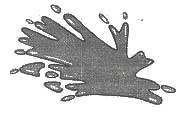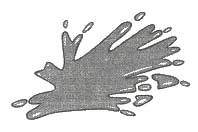As Beven Varnon wrote to me inside the cover of his book, On the Banks of the Blanco, "Your grand- mother says you are an aspiring writer, so read the story on page 51 and get busy." I hope that being aspiring doesn't expire since I am still on that journey of becoming. Recollections of my previous literary encounters fall
into experiences writing for others, then writing for myself.
Initially, these "why write" currents veered apart, but now I'm aware of times when they approach each other, almost converging like streams to create a river to the sea.
I was swept along with a tide of writing for others as early as age eight. My family drove from Houston almost every other weekend to visit my grandparents' hill-country ranch. I remember climbing Lone Woman Mountain, the highest point in Hays County; watching morning clouds race from the rising sun toward distant soft, blue hills; smelling cedar trees, limestone rocky soil, breakfast bacon, and my
grandmother's Chantilly perfume; and hearing sheep bleating, deer snorting,
and wild turkeys calling from the creek. I smile at these family memories. Since
my grandmother would always cry when we left to go home, I began leaving her a poem at the end of each stay. These verses usually described something memorable and praised her good cooking, our family and its closeness, and hill-country beauty. From those scraps of poetry is a haiku from 1960-something:
Bright, dancing fall leaves
form circles in the brisk wind
'round our family
|
The pillow poems that I left in my room continued for the next decade, appearing less frequently after I moved away from home. However, my parents still find a poem on the refrigerator door after each of my Texas treks to see them. To my delight, my daughter recently left me a poem on her chair before she drove back to college. My other daughter gave me a Mother's Day poem. I strongly connect with Tom Romano's suggested reasons for writing: to make personal sense of life's
experiences, to wonder and imagine, and to participate with knowledge toward owning it (Romano, 1987).
My creative energy ebbed and flowed among my early school adventures in writing for others. I survived writing about assigned topics, sometimes even developing unique ideas! I composed poems for friends and as family gifts. I ran aground briefly in high-school English, when an original sonnet was returned dripping with red ink. Consequently, I avoided that poetic form forevermore. Then, my com-
posing changed its flow.
One of my most meaningful undergraduate courses was about art in the elementary school. During one semester, we chose independent study topics. My professor knew that I liked poetry and suggested that I create poem books, each reflecting a
different technique of book illustration. I still marvel at my explosion of literary and artistic effort through haiku, limericks, and free verse with pen and ink drawings, acrylic and watercolor paintings, and collage. My writing for others continued in new hues and depths.
I waded cautiously into the unexplored waters of writing for children. My mind was saturated with topics from my teaching elementary school children. Equipped with ideas, resource books, a course on writing for children, and excitement about creating, I plunged into story writing. Still shaping my literary voice, I studied the
lives and writing styles of two authors who intrigued me, Beverly Cleary and
Ernest Hemingway.
I empathized with Cleary's love of nature's beauty as she grew up on an Oregon farm. Like I had done as a child at my grandparents' ranch, she dressed very quickly in winter by the wood stove in her farmhouse. Cleary's early teachers caused her to fear school like my seventh-grade English teacher had done to me. Cleary shared my
enjoyment of entering writing contests in spite of our having had high school
papers returned ".. .inflamed with red pencil corrections" (Cleary, 1988).
Despite my early times similar to Cleary's, it is Hemingway's life into which I secretly wish to steer my literary being. Ernest Hemingway's collective experiences flowed into his writing, which has been described as colorful, detailed, penetrating, original, and powerfully simple. This adventurous man traveled; lived and wrote in distant places; risked his safety for his zest for life by covering the Spanish Civil War as a journalist; loved bullfighting and the running of the bulls in Pamplona, Spain; hunted big game and deep-sea fished off Cuba. Hemingway refused to change his writing style to conform with magazine markets, in spite of the pressure of rejection slips. His third wife even shared my name-Martha!
Hemingway wrote:
There are some things which can-
not be learned quickly, and time, which
is all we have, must be paid heavily for
their acquiring. They are the very sim-
plest things, and because it takes a
man's life to know them, the little new
that each man gets from life is very
costly and the only heritage he has to
leave. (Richards, 1968)
|
I further draw upon the literary strengths of these two author models as I read excerpts of their works before I compose. This fills my mind
"…like water,
composing is
essential for
survival…of the
mind and of
the soul."
|
with their essences, which then ripple from me into my writing. I wrote "The Basket Birds," "Useful Ugly Bugling," and other children's pieces that are still seeking markets. Then I had a poem published in an anthology of works by unknown and untried poets, oddly entitled The World's Best Loved Poems. The poem "Wait" goes:
spinning
in a revolving door
while
blurred faces
pressed
against the glass
strain
to see firsthand
the
annihilation
of
a mind
please, wait
|
In 1989, waves of further change pulled me from only writing for others. I participated in a New Jersey Writing Project, Texas summer institute and discovered reflexive writing- writing for myself. I dove into it with literature, discovered treasure in collected knowledge and memories, and explored my writing process. I began to share thoughts, feelings, and learning with myself in journals where no one intruded or criticized. I extended my professional extensive writing and have had two articles published in Writing Teacher. My creative streams
of writing for others and self merged into a stronger, more individualistic surge of voice. Now I happily allow this to spill into my classroom, drenching my students with love of literacy and splashing at the heels of my colleagues as we continue to learn about teaching writing and nurturing authors in the Capstone Writing Project and Tuscaloosa public school systems.
Why write? Write because, like water, composing is essential for survival. .. of the mind and of the soul, for clarifying knowledge and reshaping it, for washing upon life's happenings and exposing meanings, for bursting into new waves of imagination ... and wondering how "Newness always leaves an aftertaste
of something ancient" (Els, 1994). An ancient river?
Martha Lockard teaches grades combined grades 4/5 multi-age and is teacher
coordinator at Central Elementary program: U.P. Magnet School in Tuscaloosa City Schools. She is also co- director of the Capstone Writing Project, University of Alabama.
REFERENCES
Cleary, Beverly. (1988). A Girlfrom Yamhill: A Memoir. New York: William Morrow
& Co.
Els, Susan M. (1994). Into the Deep: A Writer's Look at Creativity. Portsmouth,
NH: Heinemann.
Richards, Norman. (1968). Ernest Hemingway. Chicago: Children's Press.
Romano, Tom. (1987).
Clearing the Way: Working with Teenage Writers. Ports-
mouth, NH: Heinemann.
Varnon, Beven. (1983). On the Banks of the Blanco: A Hill Country Editor's View of
Life. Austin, TX: Eakin Press.
|



